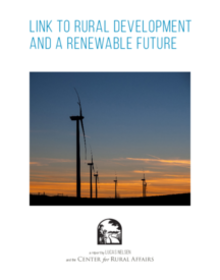The United States continues to develop new clean and renewable energy resources to replace aging, carbon-emitting generating facilities. Much of the new renewable energy generation can be found in lightly populated rural areas. These locations often host significant resources for renewable energy generation and provide ample space for new development, especially from wind energy.
Wind energy contributed a significant portion of new generation completed in 2015, making up 41 percent of a total 14,468 megawatts built last year. Many of these new additions were located in the Midwest and Great Plains, regions of the country that boast some of the richest wind energy resources in the nation. Rural communities in these regions stand to benefit from new renewable development, as projects provide new economic activity and revenue for these areas.
Projects provide new tax revenue to rural communities and supply added income for landowners. Also, the building and operation of these facilities bring new jobs to the area. The Bureau of Labor Statistics noted that wind turbine technicians are the fastest growing profession in the country. The Department of Energy estimates the wind energy industry could support up to 380,000 jobs by 2030, a significant increase over the current 88,000 jobs. However, while rural areas have significant potential to generate renewable wind energy, development has traditionally been hindered by a lack of means to transmit that power.
Without sufficient transmission, there is a limit to renewable energy development in rural places. Transmission infrastructure has been a persistent barrier to renewable energy in the Great Plains and Midwest, especially for rural areas. Electric transmission was traditionally built to service areas with sizeable populations or provide service directly to large individual generating units, leaving rural production areas without necessary transmission capacity.
Without improved electric transmission infrastructure to transport new renewable energy to market, developers are less likely to continue building renewable generation on pace with previous years. For the renewable energy industry to continue to grow, the transmission system must be updated to connect areas where projects are developed to the larger grid and to deliver renewable power to consumers.


